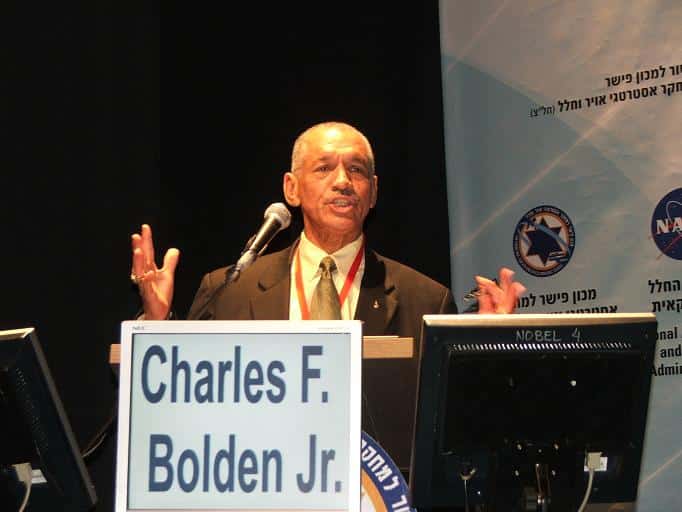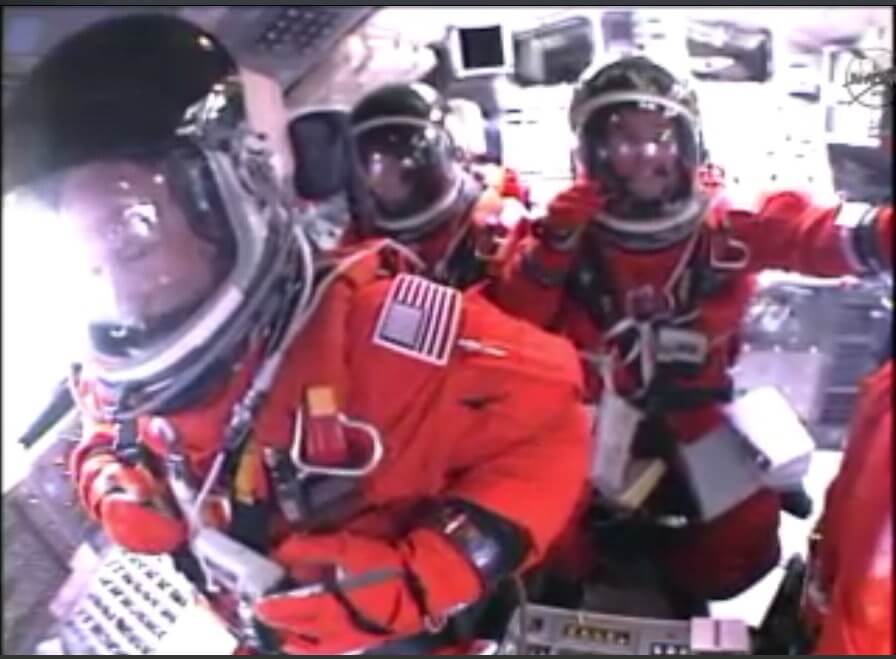The end of the space shuttle program is not the end of NASA, or even the end of NASA's ability to send humans into space. says NASA Director General Charles Bolden on the agency's website, trying to reassure those who are worried. Judge for yourself if he succeeded

"As a former astronaut and current NASA administrator, I tell you that American leadership in space will continue for at least the next half century because we have laid the infrastructure for success - and failure is not an option." Charles Bolden, NASA Administrator, National Press Club, July 1, 2011″
An article written by Bolden on the NASA website that tries to calm those who fear the loss of American hegemony in space. Judge for yourself.
"The end of the space shuttle program is not the end of NASA, or even the end of NASA's ability to send humans into space. NASA has a solid program of spaceflight, technology development and scientific research that will continue for many years to come. Here are some examples of what is in store for NASA:
Manned flights
NASA is planning and building capabilities to launch humans to explore the solar system, and is moving towards landing humans on Mars. We are currently building the multi-purpose crew vehicle, based on the design of the Orion capsule, which will be able to carry four people for missions of up to 21 days.
We will also soon announce plans for heavy launchers that can carry us into low Earth orbit. We develop the technologies required for manned exploration of the solar system, including solar-electric propulsion, in-orbit refueling systems, radiation protection and reliable life support systems.

The International Space Station
The International Space Station is the greatest masterpiece of human activity in low Earth orbit. The space station is manned by a full crew of six people, and American astronauts will continue to live and work in space 24 hours a day, 365 days a year. Part of the American complex on the space station has been declared a national laboratory and NASA is committed to using this unique resource for scientific research.
The space station is a testing ground for space technologies such as autonomous refueling of spacecraft and satellites, advanced life support systems and a human-robot interface. Commercial companies are on their way to provide cargo flights and crew members to the International Space Station, which will allow NASA to focus its attention on the next steps within the solar system.
Aeronautics
NASA is researching ways to design and build safe, fuel efficient, quiet and environmentally friendly aircraft. We are also working to create air traffic management systems that are safer, more efficient and more flexible. We develop technologies that improve routing during flights and allow planes to climb and descend at cruising altitude without interruption.
We believe that it is possible to build airplanes that consume less fuel, and emit less carbon and pollutants, and we are working on developing technologies to create such airplanes. NASA is participating in an intergovernmental team to develop the next generation of NextGen air transport systems that will fly in 2025. We will continue to develop aircraft and air control systems to ensure a higher level of safety.
science
NASA carries out an array of missions to expand our knowledge and understanding of Earth, the Solar System, and the Universe. On July 16, the DAWN spacecraft will arrive for a year-long visit to asteroid Vesta to help us understand the earliest chapter in the history of the Solar System. In August, the Juno spacecraft will be launched to investigate the origin of the planet Jupiter, its structure and atmosphere. The September launch of the National Polar-orbiting Operational Environmental Satellite System Preparatory Project will mark an essential step in building a new generation of Earth monitoring satellites.
NASA is returning to explore the moon's gravitational field to understand the structure of the moon's interior with the October launch of the GRAIL spacecraft. In November, the new Mars laboratory known as Curiosity was launched on a journey to Mars to look for evidence of bacterial life on the red planet, and in February 2012, the Nuclear Spectroscopic Telescope Array was launched to search for black holes, map supernova explosions and study active galaxies most.
For information on the NASA website
http://www.nasa.gov/multimedia/videogallery/index.html?media_id=101615961

7 תגובות
Today there is no plan for launchers to Mars with ready-made technologies of accelerated rocket propulsion and nuclear propulsion.
Nothing happens in the world - nothing has stopped, but there is no plan.
The greens oppose nuclear propulsion but without it we cannot reach another planet.
Getting to Mars is the next goal that should be.
NASA director, an appointment of President Obama, lacks vision and no budget.
There is a secret Lockheed Martin fighter plane - secret in the sense that the technology is not revealed like in the B2 and F117 at the time.
It is rumored to have anti-gravity propulsion. How is the magnetic field canceled - perhaps using a magnetic field. A situation where at a point in space the force of gravity is eliminated. Without gravity - this is a new form of propulsion.
on the plane without any information
http://en.wikipedia.org/wiki/Lockheed_Martin_RQ-3_DarkStar
About the technology - search on GOOGLE.
The space shuttle had a lot of impressive and well-known successes but to understand why they decided to ground it
You need to know what the weaknesses of the system are according to the perception of the decision makers who brought them to the ground,
One of the main goals of the shuttle was to reduce costs in sending cargo and people into space,
In this central goal, it failed, not only did it fail, the costs increased,
In addition to this, due to its enormous complexity, it attracted a large amount of financial and human resources from NASA,
And basically stopped the development of manned flights because most of the resources according to its categories
We were directed to its maintenance and not to the development of alternative and innovative systems,
The main reasons for its high price are tremendous complexity, which means a high risk of failure and requires crazy maintenance
And the second thing comes from the combination of the means of propulsion and their price compared to the structure of the ferry,
The structure of the shuttle is intended for multiple use + accurate landing at the base and not at sea and thus will save costs
of using a disposable system,
But the idea clashed with the huge costs incurred for each kg sent into space and the high costs involved in returning such a system to flight mode again, because the shuttle is built for multiple use, it is heavy, it has many systems that support multiple use and these systems have a high weight + including
Complicated landing systems that require expensive maintenance,
The end result of all this that the price for the flight is astronomical,
Ironically the system of the old steel Soyuz capsule beat Apollo and what the Chinese are building is much cheaper
And safe to fly from the sophisticated shuttle.
The big disadvantage of grounding is that the shuttle had other elements that are not in the capsule, so the capsule is only intended for
for sending cargo or people but not the combination that is currently in the shuttle including the possibility to fix a satellite like a telescope
Hubble space, on the other hand, the catalogers will say that it is better to send another telescope than to send a shuttle to repair it
At least in terms of price,
And the International Space Station would not have been able to be built without the shuttle including its robotic arm.
So once they finished their commitment to the International Space Station
They decided to ground the shuttle.
First of all congratulations on the new design of the site.
The problem, in my opinion, is that NASA does not manage to maintain a development sequence regarding the launchers. It abandoned the development of the one-time heavy accelerators of the Saturn 5 type in favor of the development of the space shuttle, and now it will have to develop heavy accelerators from 0. It did not continue the development of the space shuttle: in the nineties it should have applied the conclusions and lessons learned and developed the second generation. Surely we would be in a different place today if there were third generation ferries. Now this knowledge is also going down the drain, until someone in the private market will be able to develop their own shuttles - and again from phase 0 (today these guys can't even reach orbit - back to the 50s).
It can be compared to what the "Boeing" company did to stand up for the size of the mistake. The new planes of this company are based on previous generations, mainly on the 707. The 707, for its part, is built on technologies developed (mainly by Boeing) in earlier decades, including a compressed passenger cabin, B-29 and more... Where is NASA's development sequence?
The private market is already getting into it, SpaceX's Dragon capsule will begin service flights to the space station next year
http://www.spacex.com
This is a decision by the President of the United States that does not even make economic sense.
Until there is no replacement space vehicle, we must work with the expensive shuttles to maintain, and improve the maintenance as necessary. The loss of hegemony is forever, unless they come to their senses. If the price of reliability is redundancy checks before returning to DHA, and working around the clock - then this is the price. Against not only the launch cost but the loss of hegemony.
The Soyuz is really safer. without cynicism.
Out of 135 shuttle launches - 2 exploded. (1.5% of launches)
For Soyuz, and the missile that carries it (I'm only talking about the missile) - a reliability of over 99.9%.
(one failure in more than a thousand launches)
I hope I haven't opened my mouth to the devil now, and there will just be a malfunction in Soyuz.
The fact that the ferries contain 20-year-old computers is no secret..and the fact that they need to be replaced is also no secret..
But between that and completely canceling the thing that most symbolizes the American spirit is pure stupidity on the part of Obama..
The private market will get into it, but it's not something that's happening now, it will take at least another decade plus or minus
Until then, the Russians were stuck with the fact that they had to use their Soyuz to fly the Americans up... because it is of course a thousand times safer (some sarcasm??)
If Obama would only cancel and switch to another model, let's say...but he cuts them a nice 9-figure sum at the same time, as far as I know...it's good to know that he has billions to do nonsense in Libya (only God knows what the hell he's looking for)...but giving it to NASA is not .